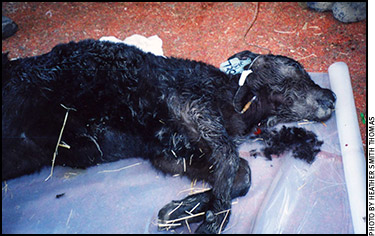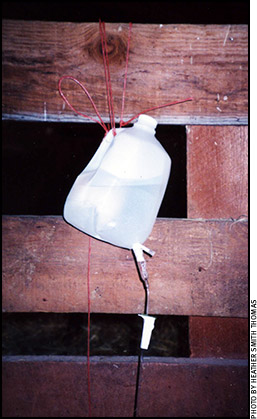Emergency IV for Dehydrated Calves
When a sick calf is past the point of being able to absorb oral fluids, the only way to save that calf is with intravenous fluids.
Sometimes, when a sick calf is weak and dehydrated from scours and past the point of being able to absorb oral fluids, or is in shock from septicemia, intravenous fluids are the only way to save it.

Cutline.
Having the proper size needle to go into the jugular vein, an intravenous (IV) catheter and tubing, and bags of sterile IV electrolyte solution on hand can save a calf that might not survive a long trip to the veterinary clinic. Even if you don’t have an IV solution, a gallon jug of distilled water and some baking soda can turn many of these calves around, says George Barrington, veterinarian and professor of large animal medicine at the College of Veterinary Medicine at Washington State University.
“In our clinic we use isotonic bicarb, but you can also use plain baking soda. It’s essentially 13 grams of baking soda per liter of water, which is almost a quart. We make it up in the pharmacy here, but I’ve also used just plain bottled water. You can also use a gallon of distilled water and figure out how much soda to add,” says Barrington.
About 20 years ago veterinarians at the Caine Veterinary Teaching and Research Center with the University of Idaho started teaching ranchers who were a long way away from the veterinary clinic how to do this. Their instructions were to fill a plastic syringe cover of a 20-cc syringe to the top with baking soda, and put that in the gallon of water. This amount is very close to what you’d weigh with a scale. You can use a regular rubber IV bottle topper and stretch it to slip over the gallon jug’s top. Or, you can simply insert the IV tube — the sharp tip that’s designed to penetrate an IV bag — into the bottom of a plastic gallon jug of distilled water that has been warmed to body temperature.

Cutline.
Once you get a needle into the jugular vein of the calf, let the IV tubing fill with water to get all the air out of it, then attach it to the inserted needle. You can control the speed of the flow with needle size; a small needle in the vein will keep the flow down to a safe speed. For a calf that’s flat out, you can usually run the fluid in faster without problems; these calves have low blood pressure and can take the additional fluid pretty quickly.
Most calves will get up after a gallon of this fluid is given. They may go down again if they are actively scouring, but you can repeat the fluid — give them another gallon — if they do go down again. If they don’t get up after a gallon, or don’t look like they are improved, their problem is usually more complex and not just scours, and you are probably not going to get them up.
“We often do the same thing here, using a syringe cover to measure the soda, because it’s quick and easy,” says Barrington. “We just stress that you keep everything clean, using distilled or bottled water. Have a plan, and know how much soda to use. This can be a lifesaver for a calf, and the thing that turns them around to where they become strong enough to take some oral fluids. If you are a long ways from a veterinarian, being able to do this yourself could save a calf’s life,” he says.
“Most veterinarians are willing to give advice and help ranchers learn how to handle a lot of things, because our goal is to have our clients lose as few calves as possible,” Barrington emphasizes.

Editor’s Note: Heather Smith Thomas is a cattlewoman and freelance writer from Salmon, Idaho.






